Red tail sharks (Epalzeorhynchos bicolor) are one of the Cyprinids, labeled as a freshwater shark based on their appearance.

They fit the stereotypical shark image with prominent, triangular dorsal fins and a narrow, torpedo-shaped body.
Red tails also have reputations for aggression. Establishing adult territories within their aquariums, they’ll pursue any fish that dares to encroach on their turf relentlessly.
The “shark” similarity ends there, though, as these pint-sized bullies lack ferocious jaws.
If you love sharks but don’t have the space for a monstrous tank, red tail sharks might represent the perfect compromise.
However, these striking freshwater carps require a little more experience than other fish. Red tails don’t do well with beginners.
At a Glance
| Minimum tank size: | 55 gal (208 l) |
| School size: | MUST be housed alone |
| Temperature: | 72-79°F (22-26°C) |
| Lifespan: | 5-8 years |
| Size: | 4-6 inches (10-15 cm) |
| pH: | 6.5-7.5 |
| Hardness: | 10-15 dH |
| Ammonia: | 0 ppm |
| Nitrite: | 0 ppm |
| Nitrate: | 0 ppm |
In this article
In the Wild
Red tail sharks originally infiltrated the central region of Thailand.
The Bueng Boraphet freshwater lake and surrounding swamps once teemed with these black and red marvels. But those colors surged in aquarium popularity, prompting collection to soar.
In 1996, the red tail shark found itself labeled extinct in the wild. Aquarists weren’t the only ones to blame, though.
Habitat loss restricted their preferred streams and rivers. These scrappy little fish want healthy waters full of vegetation, rocks for hiding, and driftwood.
Then, in 2011, a small remnant population surfaced. Critically endangered is a better listing than extinct, though not by much.
Most of the red tails purchased for home aquariums now come from captive-breeding programs.
Manageable Shark Size
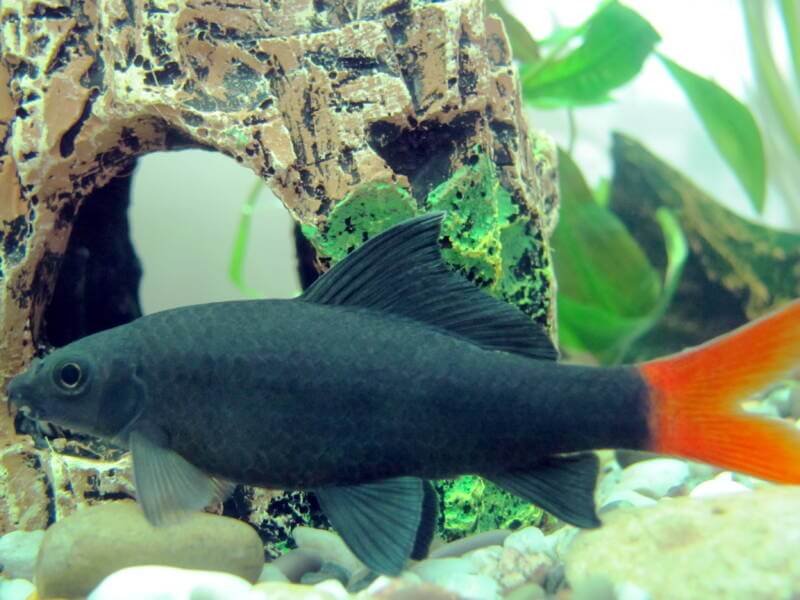
Compared to large freshwater sharks (specifically, the bull shark), red tail sharks come in a more reasonable size for aquarists to handle.
At adult length, they top out around 6 inches (15 cm). This requires proper care and management, of course.
With optimum care, your red tail can reach a length of around 8 inches (20 cm).
Even if you don’t see that perfect ideal, rarely do aquarists see their sharks end up smaller than 4 inches (10 cm) – not without something wrong in the genetic code.
Lifespan
Red tail sharks live for an average of 5-8 years. That’s not bad for a freshwater fish.
Of course, if you’re on top of your water quality and food regimen, you might get the chance to extend your red tail’s lifespan to 10 years.
Behavior
Red tail sharks follow the instincts and behavior patterns of the larger species they’re named for: they’re solitary.
In general, you can only keep a SINGLE red tail shark in your tank at a time. Otherwise, you’ll end up with severe aggression problems.
Unlike other members of the Cyprinidae, red tail sharks have no interest in schooling.
If you provide a large enough tank, you CAN get away with keeping more than one red tail at a time. But the aquarium’s going to end up MASSIVE, and you’ll need FIVE red tails MINIMUM.
Realistically, most aquarists don’t have the spatial resources to allow for a group of red tail sharks.
Providing enough room (and patience) for that natural hierarchy to develop is asking a lot. This is why most people stick to one vibrant red tail at a time.
Tank Setup
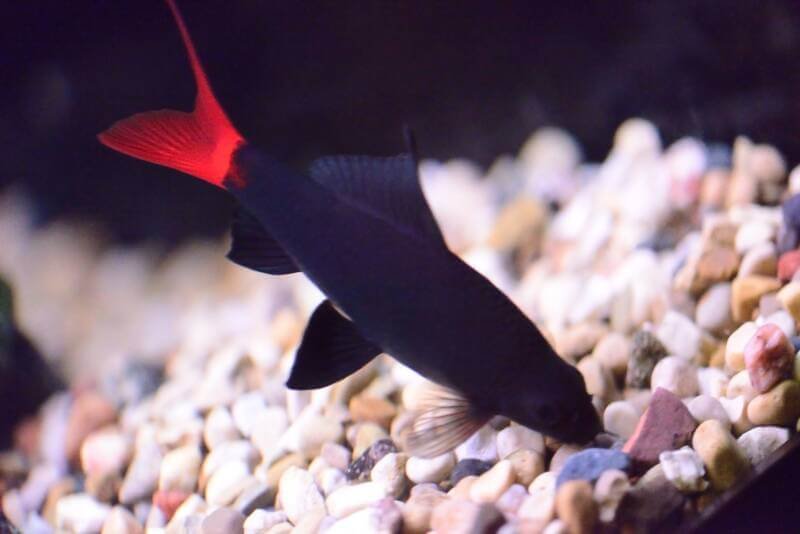
Setting up a 55-gallon (208 l) tank for such an average-sized freshwater fish sounds excessive.
However, red tails have that aggressive shark streak. Force them into a smaller aquarium, and they’ll turn into giant bullies.
Providing plenty of space to cruise around the tank will bank those hostile fires.
Just resist the temptation to overcrowd the aquarium simply because you have extra room. If red tails feel hemmed in, they’ll start taking it out on their tank mates.
Red tail sharks have powerful swimming muscles – and powerful jumping muscles. Invest in a sturdy lid for your aquarium.
This will not only protect your red tails, but it’ll also prevent any potential escapes by your other fish (just in case – no one wants to find a fish on the floor).
Unlike mollies and Shubunkin goldfish, red tail sharks don’t produce a ton of waste.
You don’t need to invest in a crazy filter to keep up with them. A simple HOB filter (such as the Aquaclear Power Filter) works just fine.
You need to add in air curtains or air stones to provide some additional water movement, though.
In the wild, red tail sharks prefer streams and rivers with a strong current to them. A single HOB won’t provide enough water flow to keep them happy.
Water Conditions
Thailand boasts a tropical climate. You want to aim for the higher end of that 72-79°F (22-26°C) temperature range.
You’ll keep your red tail shark active and happy if you avoid dips into the colder regions.
The central lakes and swamps of Thailand feature neutral, moderate waters.
You want to replicate that environment the best you can with a pH range of 6.5-7.5 and a water hardness of 10-15 dH.
You also need as close to pristine water conditions as possible.
Decorating the Red Tail Shark Tank
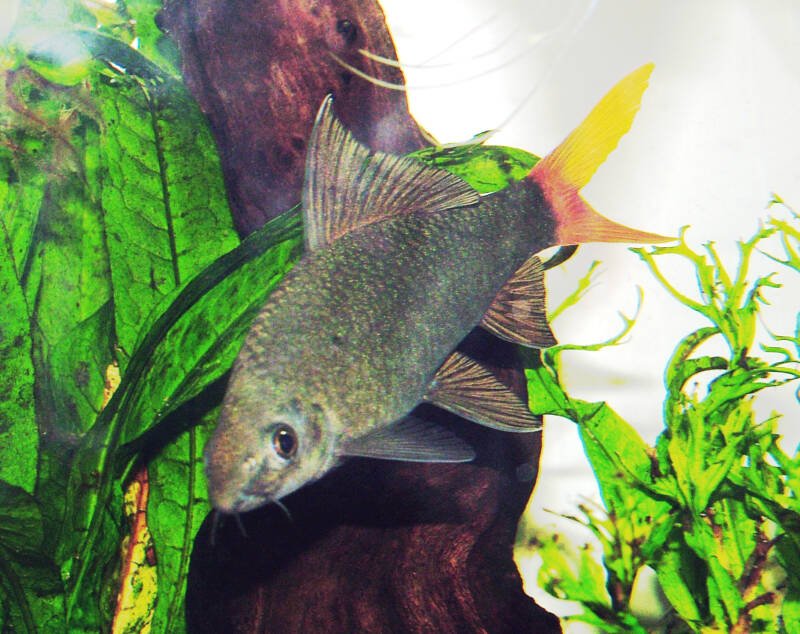
Red tail sharks are predominantly nocturnal. You can gradually adjust them to daytime activity by keeping your lights as low as possible. Your other option is to provide natural “shade” with floating plants.
While omnivorous, red tails don’t tend to snack on the greenery in an aquarium.
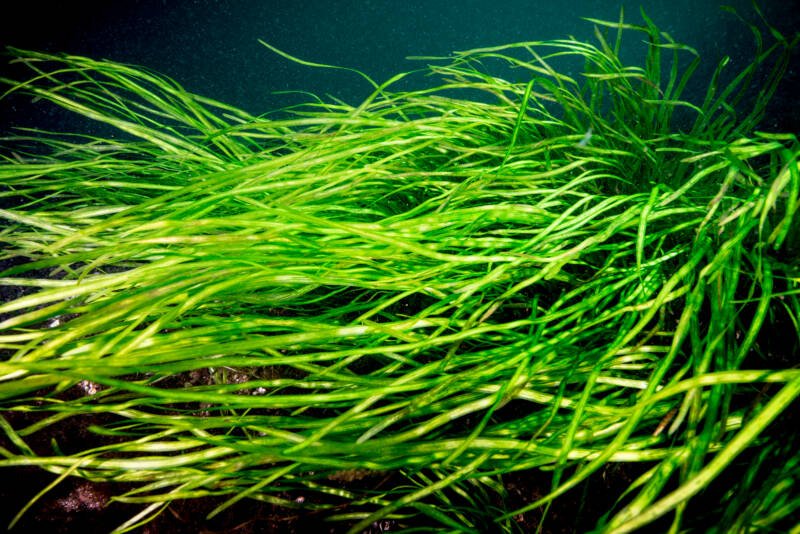
You don’t want to crowd the swimming space, but feel free to add clusters here and there to break up the lighting:
- Amazon sword
- Aponogeton
- Brazilian pennywort
- Dwarf sagittaria
- Eelgrass
- Guppy grass
- Hornwort
- Java fern
- Red flame sword
- Water wisteria
Despite their aggressive tendencies, red tail sharks prefer to hide out in the décor.
You want to provide driftwood, rocks, and caves for them to escape to when they need some alone time. Red tails spend a lot of time near the tank’s bottom, so spread these along the substrate.
When selecting your substrate, choose a larger gravel size. Red tail sharks scavenge the bottom, and they may accidentally ingest smaller substrate sizes, especially sand.
If you use medium pieces or larger, you’ll avoid that problem.
Make sure to avoid any decorations with reflective surfaces. You can’t forget that bullying habit of red tail sharks.
If they catch a glimpse of “another red tail,” they’ll exhaust themselves trying to go after the intruder.
Red Tail Sharks in Communities
While you can’t have more than a single red tail shark per aquarium, you don’t have to avoid a community tank altogether.
With the proper tank mates, you CAN add that splash of red and black into your tank, letting that prominent dorsal fin cruise through the water.
Tank Mates
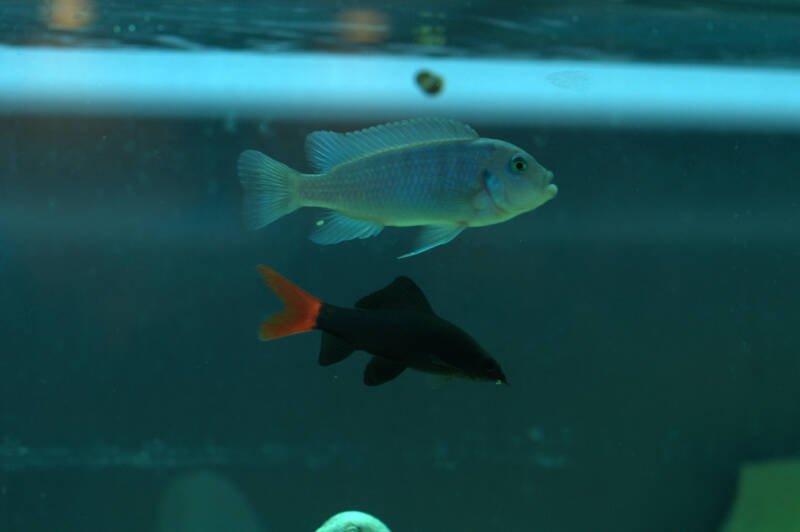
It’s impossible to guarantee which species a red tail shark WON’T decide to bully.
If they feel another fish has intruded on their turf, they’ll harass and hassle a fish to the point of extreme stress. They don’t bite, but stress CAN kill.
Fish that can hold their own on the aggression chart do just fine when confronted with a red tail shark.
So do some of the strongest schooling freshwater fish, which are less likely to find themselves singled out for harassment:
- Cichlids
- Bala sharks
- Buenos Aires tetras
- Congo tetras
- Dwarf gouramis
- Honey gouramis
- Neon tetras
- Sparkling gouramis
- Pearl gouramis
- Tinfoil barbs
Incompatible Species
Any sweet-tempered, slow-moving fish shouldn’t find themselves mixed in an aquarium with a red tail shark.
The poor fish could find themselves shoved away from food sources, pushed into the plants, or even pressed into corners.
You also want to skip fish with flowing fins, such as freshwater angelfish and bettas. Red tails know to worry at the dangling appendages, leading to fin rot and other infections. Even without a real shark’s fearsome teeth, these bullies know where to strike.
You absolutely CANNOT add rainbow sharks into a community tank with red tails!
The two species share similar appearances, and red tail sharks can’t tell the difference. They’ll view a rainbow as a red tail and pursue them relentlessly.
Feeding and Diet
Despite the word “shark” in their name, red tail sharks are omnivores.
They don’t get picky about what appears on the menu – one of the simplest parts of their management. In the wild, they feed on insects, plants, and crustaceans.
You need to observe your red tails for their preferred feeding location before you purchase your base food.
Surface-feeders do fine on standard flakes and pellets. But most red tails stay at the bottom, and Hikari Sinking Wafers do a better job of reaching them.
If you want to provide the highest amounts of protein to your red tail sharks, alternate between frozen and live varieties.
You’ll boost their activity level and keep that bright red tail looking its best. Red tails particularly enjoy:
- Brine shrimp
- Bloodworms
- Tubifex worm cubes
And don’t skimp on the vegetables! Remember, red tail sharks won’t snack on your tank’s greenery.
You’ll need to peel and blanch their favorite veggies and add them to the tank to keep them in tip-top shape:
- Cucumber
- Peas
- Zucchini
Red tail sharks only need twice-daily feedings. Monitor them closely to ensure you don’t see scraps disappear into the substrate; it’ll create excess nitrogenous wastes.
If they can’t finish what you offer in 2-4 minutes, cut back a little.
Breeding: It’s a Mystery
The odds are high you’re not going to succeed in breeding your red tail sharks. (Don’t take it personally)
Aquarists struggle with getting two red tails to tolerate each other under the best circumstances, much less long enough to produce eggs.
The captive-breeding programs that produce red tails for the aquarium industry rely on hormone injections to overcome that innate aggression.
The average aquarist doesn’t have access to that hormone. So you’re probably NOT going to succeed (sorry).
Male or Female?
Male and female red tail sharks both share the vibrant black and red color.
The only way to tell the difference between the two is to look at the belly region. Females have a slightly rounder stomach (designed to hold the eggs).
To Breed or Not to Breed?
If you want to breed your red tail sharks, you first need to hope you have a male and female.
Telling the two apart is difficult, and they’re aggressive toward each other even during the spawning season!
Aquarists know red tail sharks spawn in caves, so preparing one of your grotto areas with a lining of eelgrass might tempt your female to get “in the mood.”
Of course, she has to tolerate the male’s presence, and then they need to NOT consume the eggs. It can get frustrating.
Fry take 30-60 hours to hatch. They start swimming around after four days.
Initially, red tail fry have a silvery-brown color. You won’t see the black develop for a few days, and the red tail doesn’t appear until about ten weeks.
Health & Disease
Red tail sharks don’t develop any species-specific diseases. They’re relatively hardy freshwater fish.
Unfortunately, they stress out at the drop of a hat. And stressed fish end up prone to infection and illness.
Red tail sharks are more prone to ich, fin rot, and velvet disease than other freshwater fish.
Avoiding these infections relies on maintaining pristine water conditions, avoiding overcrowding, and providing the most swimming space possible.
Luckily, red tail sharks provide indicators of “something’s wrong.” As they start to grow stressed, you’ll notice the following changes take place (in this order):
- Those beautiful red and black colors will grow pale.
- You may even see other signs of discoloration.
- They’ll exhibit difficulty breathing.
- The edges of their fins will develop a “frayed” appearance.
- Their body condition will deteriorate.
- They’ll become weaker swimmers.
The sooner you react and check your tank’s conditions, the more likely you will interrupt the problem.
Most red tail illnesses are simple to treat with primary medical therapy. But if you only need to fix the water quality? That’s a lot easier.
Red Tail Sharks: Are They for You?
Aquarists love red tail sharks. That stark contrast of black and crimson appeals to a lot of people. Set against a background of green, the colors pop.
With an average cost of $6 – $16, they’re also reasonably priced.
However, you need to think through your decision carefully. While the majority of red tail sharks come from captive-bred programs, they ARE listed as critically endangered.
Is it responsible to bring any endangered species into your aquarium?
There are other freshwater sharks available with greater numbers in the wild. While not as vibrant, they may prove a more ecological choice.
It’s always important to balance a colorful freshwater option with the impact your decision has on the world.
Black and Crimson Carps
Red tail sharks share a lot of characteristics with the stereotypical shark. They have a prominent, triangular dorsal fin.
And while their teeth aren’t so impressive, they have an aggressive personality they use to bully other fish in the tank. It makes them a pint-sized favorite.
Do you have a community tank with a red tail shark? Are they a bully?
Have you successfully bred red tail sharks?
Share your stories and questions with us here!